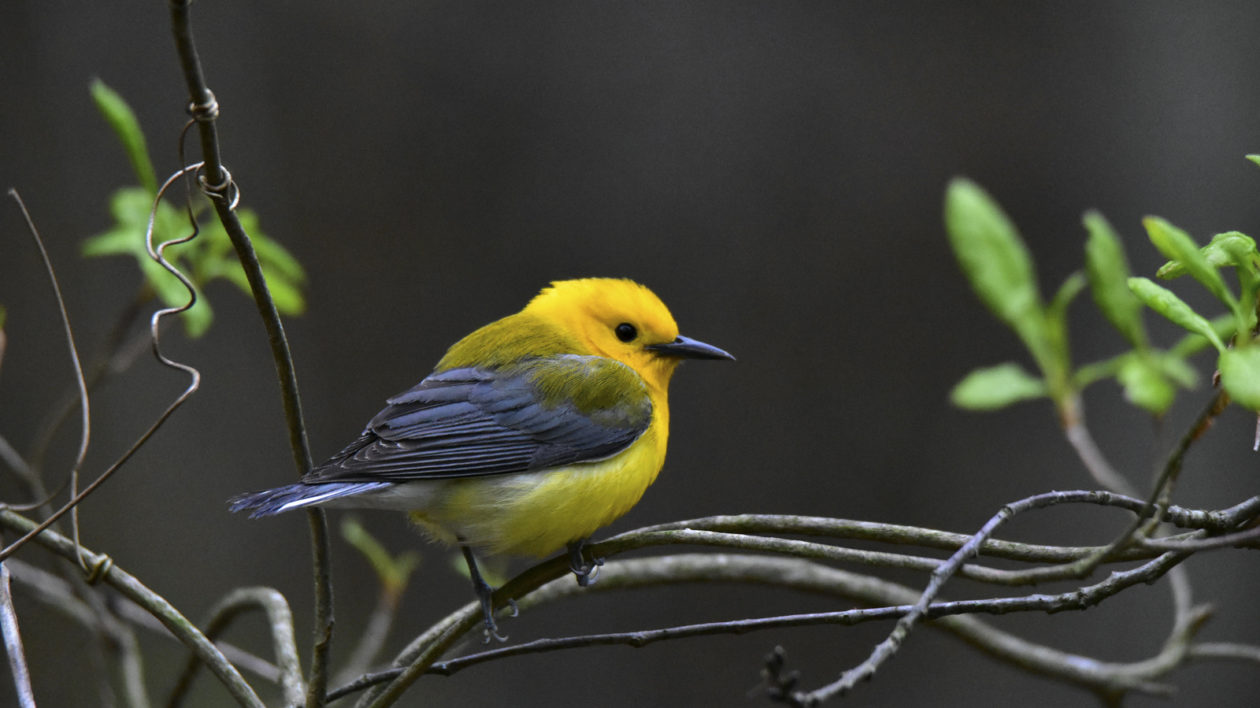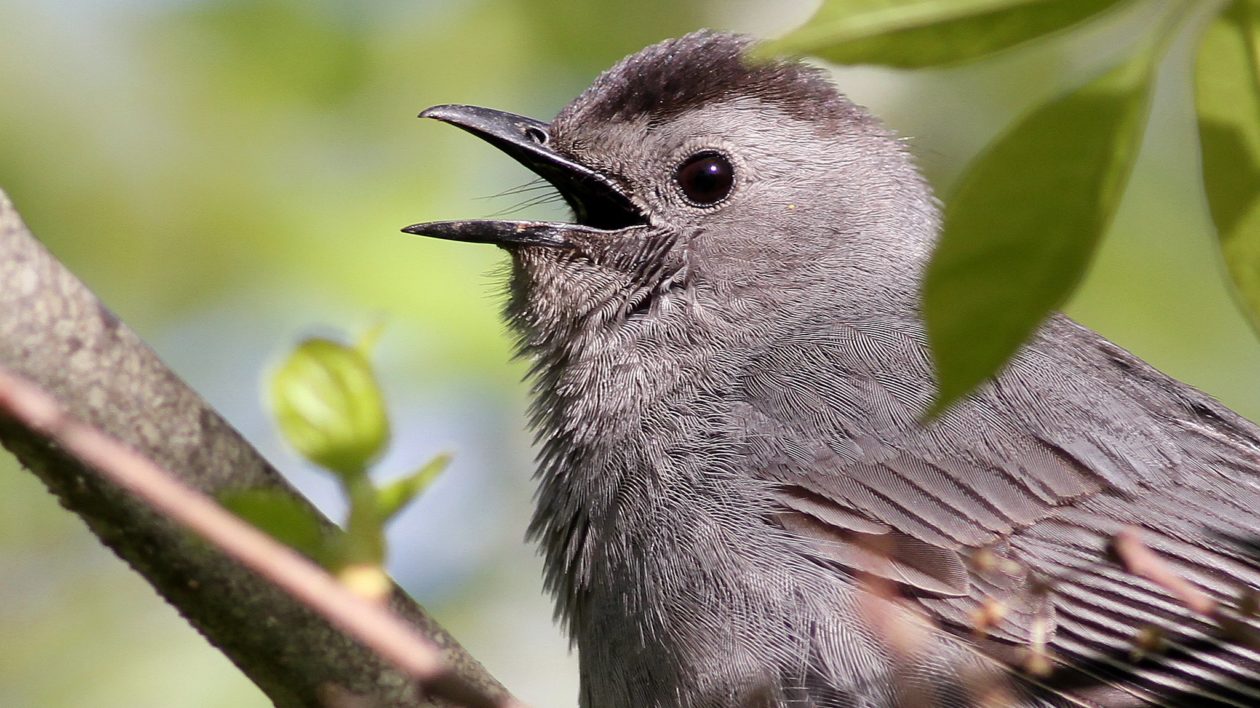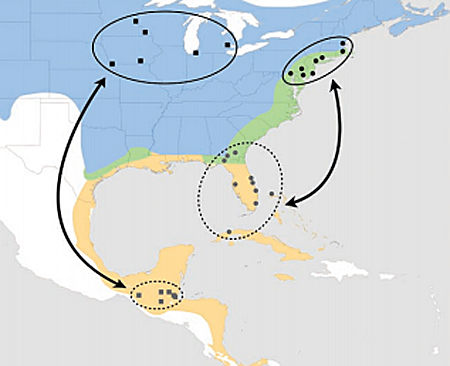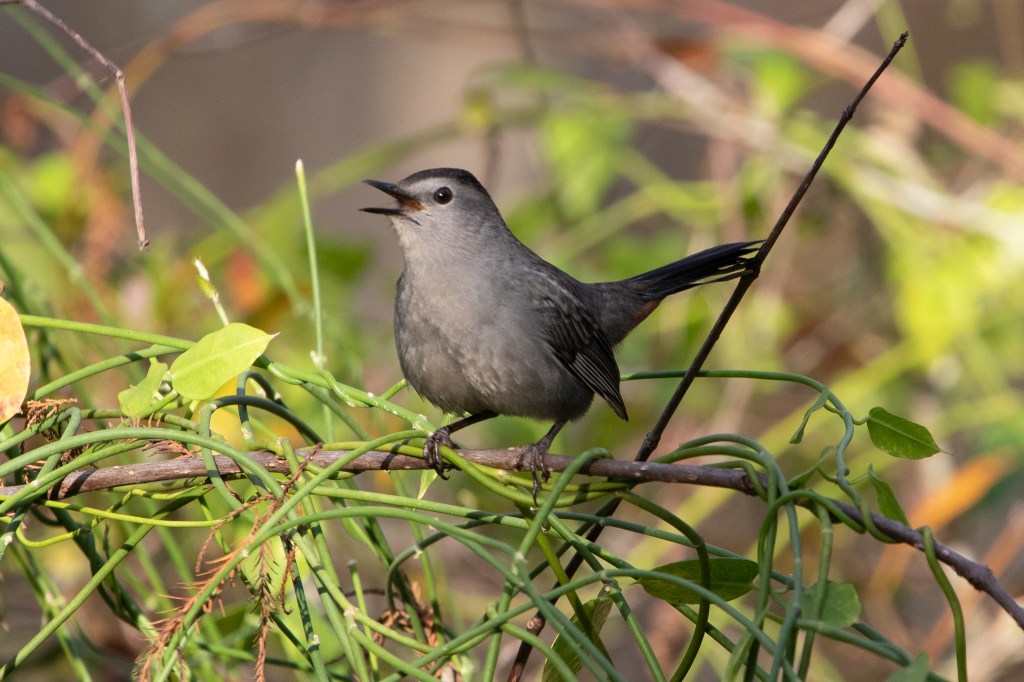Consider the gray catbird: the tropical long-distance migrant that may well be nesting in your backyard this summer.
Gray catbirds are common, so you may not pay them much attention. But look into the research, and you’ll find that this backyard bird is full of surprises. Let’s take a closer look.
As I write this, a gray catbird is singing in my backyard.
It arrived here in New Jersey several weeks ago and may already be building a nest with its mate somewhere in the neighborhood.
I am wondering where my catbird spent its winter – and whether this is the very same catbird that was in my yard last summer. Research on catbirds can help answer these questions.
Every spring, dozens of species of migrant songbirds make their way north from the tropics to settle into nesting habitats across North America. Indeed, half of all North American birds spend their winters south of the U.S. border – from Mexico through South America.
Most of these species are habitat specialists and we might see them in our backyards only briefly during migration as they make their way to more remote places.

The gray catbird, on the other hand, is a migrant from the tropics that is quite happy to claim a breeding territory in a wide variety of shrubby habitats, including suburban backyards.
The catbird singing in your backyard this spring is likely the same one that was there last year. Individual catbirds (and numerous other species) return to the same habitat patch to nest year after year, as long as they are fortunate enough to survive from one season to the next. Studies have shown a roughly 60 percent annual survival rate for catbirds.
If your backyard catbird has a lucky streak, you could see the same bird coming back for many seasons. The longevity record for a catbird is 17 years, 11 months.
This nearly 18-year-old bird was caught and banded as a young of the year in Maryland and miraculously encountered again by banders those many years later in New Jersey.
Banding can confirm the age of birds and also confirm that the bird in your backyard this year is the same one that was there last year.
Participants in programs like Neighborhood Nestwatch can observe their backyard catbirds wearing unique combinations of colored leg bands. These identify each bird as an individual and can be viewed with binoculars. For this project, researchers and participants alike can make observations on the identity and longevity of their catbirds.
Catbirds nest in 46 of the lower 48 United States and across southern Canada. They spend the winter across an equally broad area. A proportion stay in the U.S., where they primarily occupy the Gulf Coast and Florida. Some hearty individuals hang in there as far north as New Jersey.

Others go further south to the tropics – to the forests of Mexico, the Caribbean and Central America. There, they share the woods with jaguar, tapir, fer-de-lance and toucans.
Catbirds return to the same site on the wintering grounds every year as well. Your backyard catbird might spend the winter in the shadow of Mayan ruins in Guatemala or perhaps in the Florida Everglades.

We can make an educated guess on where your backyard catbirds spend the winter thanks to a recent analysis of banding records along with the use of tracking devices.
What this work tells us is that if a catbird breeds in the upper Midwest, it is more likely to be spending the winter in Central America. If it nests in the mid-Atlantic and New England, your catbird is likely spending the winter in Florida or the Caribbean.
As more studies like this one are carried out, we will have a further refined picture of “migratory connectivity” between nesting and winter sites. And we will be able to make even better guesses about where our backyard catbird might be next winter.
“A Few Raisins Give Him the Greatest Delight”
If you want to kick things up a notch for your backyard catbirds this summer, in addition to providing water, you can also offer them fruit.
As the poet Mary Oliver observes in her poem “Catbird”: “But a few raisins give him the greatest delight.”
One of the pleasures of a birding holiday in the tropics is watching birds at fruit feeders. After hours of seeking difficult-to-see skulking birds of the undergrowth and fast-flitting birds of the high tree tops, birding respite can be found at lodges and cafes that maintain fruit feeders for birds. Dozens of species of brightly colored birds come into easy view to eat banana, papaya and citrus at close range.
Catbirds bring a bit of this culture back with them from the tropics and are among the few birds at our northern latitudes that will readily eat soaked raisins, sliced orange and even grape jelly.
Back to my well-fed catbird. Is he the same bird as last year? Without banding him, I can’t know for sure. But I do know that he will do everything within his power to return here.

And return from where?
Maybe it is time to combine science with imagination. The science tells me that he wintered somewhere in Florida or the Caribbean.
But for better spatial resolution, my imagination is saying the Zapata Swamp of Cuba. Listen to what he sounds like there (in the audio file) … and then listen for the catbird in your yard!




Thank you, Joe, for this excellent and informative article. I just saw our first catbirds of the season today (May 3, 2022) in Arlington, VA. One visited our bird feeder with a gourmet mix of nuts and sunflower kernels. I had never seen them before at our feeder and came across your article to learn more. We have been enjoying them for many years as they return to our location here in the Mid-Atlantic year after year.
My house is under attack by a very aggressive catbird! he goes from window to window, I suppose attacking his reflection. It’s been like a bad Hitchcock movie for a week now, and I’ve tried the fake owl, covering the glass with brown paper (neither of which has worked, And, I’ve had to park my car outside the past couple of days so he’s after that darn reflection in the side mirror and windshield!! Argghh!!! make him stop! bird poop everywhere! I guess I need to hire a CAT! 😉
Hi Joe, I enjoyed reading your tribute to catbirds. That being said, I am in the outskirts of Phoenix, AZ and dealing with a pair of mating catbirds that have nested in my orange tree in the area that my dog uses to potty. I’m sure you can guess that now my dog doesn’t even want to go outside as she gets dive-bombed every time, as do I when I try to go with her. As a bird lover I really don’t want to disturb the birds, but my dog needs to be able to do her thing and I’m unable to walk her. Is there anything I can do to achieve a symbiotic relationship ?
The Catbirds , which appeared to be two pairs, suddenly disappeared after a torrential rain event about a months ago. We are in Kent Connecticut, northwest corner of the state. Was it coincidental, that maybe they migrated then? The Phoebe pair also disappeared at the same time.
My bird comes when I work in the yard and kind of follows me around–especially when I disturb soil. Seems to be a repeat from last year and comes quite near me without fear.
Interesting information about Catbirds! I had no idea that they migrate to and from tropical climes like Hummingbirds. However, I came to your site looking for answers as to why these birds are drinking the food we put out for our Hummingbirds… I gather from your raisin notes, that it must be the sugary potion the Catbirds like. They have a “sweet tooth” so to speak!
Unfortunately, they are keeping the Hummers from returning to their feeders.
Is there some way to keep the Catbirds away from the Hummingbird feeders?
Do catbirds scare off the Baltimore orioles?
Thanks for your information on the catbird. Two just showed up at my house a few days ago. I am enjoying them. They do not seem camera shy at all. I enjoyed your video on the catbird song.
A juvenile gray catbird flew into my deck window this a.m. it was stunned for a while below the window where i took a picture before it flew off to a adjacent oak tree branch and then off an unviewable location. I have never seen this type of bird here in Ballwin, MO just west of st. Louis. I also have for the past 2-3 years 4-5 bluebirds nesting in my backyard bluebird house. This was a welcome delight as bb’s are not often seen in suburban areas.
We live in Central Ontario Canada, about 100 km north of Toronto. For the past two winters we have enjoyed a lone catbird at our feeder during the entire frigid Canadian winter. This spring at last he was joined by another cat bird and they both sat at the feeder everyday. What I am wondering is why suddenly are they taking all of the seeds that are in the trough of the feeder and flicking them on to the ground? I teased my husband telling him that the new arrival is a female catbird who is finally showing him how catbirds should eat! ? They will empty our feeder within a whole day. Why do you think this is happening?
Hi Joe, back in May I found a catbird in the floor he was only days old. I dedicated to raised him we had a great time, till this day I call him and he comes to my hand or my head. I have a cage open with food and water, now is September and I’m worry about the winter, I see him with another catbird in the bushes, I love him so much I’m afraid if he migrates he not going to make it. should I keep safe in the cage until spring or let him go? his like a domestic pet he goes to any human around, help me please… I’m in New Jersey.
Olinda Santos